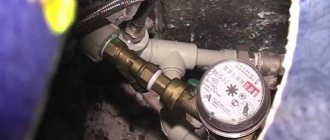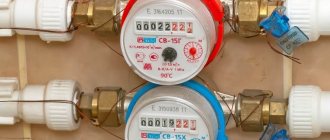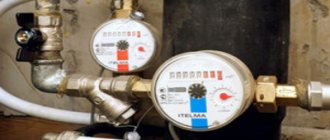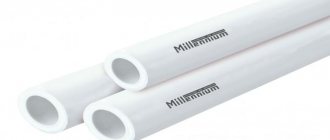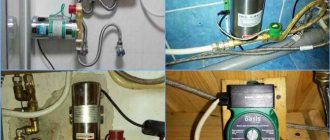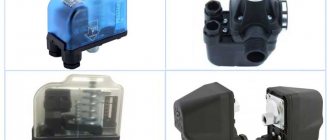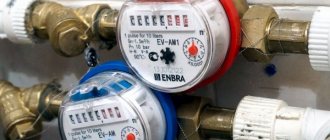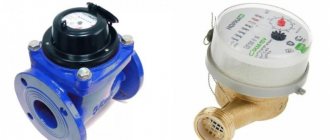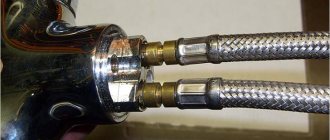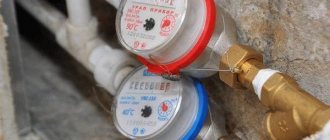Let's consider what benefits can be gained by purchasing a hot liquid meter with a temperature sensor for an apartment, and what losses can be incurred. Perhaps not everyone knows about the existence of this type of IPU.
The articles write that hot water in an apartment can damage metering devices and greatly affect their wear and tear. it occurs in an overly idealized reality. Only very hot water can really cause harm. The water meter device is quite simple, but not so fragile. Nowadays, on the contrary, they are becoming stronger, and the recommended calibration intervals are increasing.
It is not temperature that causes damage to components, but temperature changes. If there were 90 degrees Celsius in the pipes, the problem could be considered urgent, but in the best case, it’s 50. This means not only that concerns about the safety of hot water meters can be alleviated. She's not always hot. Utilities often provide water below 40 for various reasons. This is slightly warmer than the human body . A hot water meter with a temperature sensor is a good way to find out what kind of water residents are charged for and avoid expenses.
The only thing that confuses us in such circumstances is the price. It is natural that a more technologically advanced device with a temperature sensor is more expensive than less technologically advanced ones.
What it is?
A hot water flow meter with a temperature sensor is a multi-tariff meter that allows you to constantly monitor the temperature of water, record them electronically, allocating the volumes of used water into tariff cells.
This function allows the consumer to pay for DHW with a low temperature at the price of a cold one . A conventional water meter includes the following elements: an impeller in contact with water and a gearbox that transmits the impeller revolutions to a mechanical display through a magnetic gear.
Unlike this water meter, a multi-tariff device consists of three main parts:
Mechanical , which includes an impeller mounted on the turbine.
The number of its revolutions per unit time depends on the volume of water passing through the blades. An inductive (reed switch) sensor is attached to the turbine, reporting pulse data on the amount of water consumed.- Electronic unit that collects information about the amount of hot water used and its temperature.
- Temperature sensor , recording readings at certain intervals and transmitting them to the electronic unit via a cable connection.
On the display of the electronic unit, depending on the model of the device, you can see:
- the total volume of water passing through the blades;
- temperature;
- the amount of low-temperature water used is less than 40, 50ᵒС (correction factors are applied to them when calculating the total volume of water).
Some meter models may be equipped with a port for remote transmission of readings.
For this, a special device is used, which can be located at a decent distance from the electronic unit (about 10 m) and read its data. It is very convenient to take readings outside the apartment when the owner is not at home.
Hot counter with temperature control
According to these rules, water with a temperature of more than 40 degrees will be legally considered hot. But it often happens that for one reason or another, water flows from a hot tap at a temperature lower than that established by the rules. Agree that it is hardly possible to take a comfortable bath in such water.
The New Year for most Russians is not only pleasant hopes, the joy of the holiday, the aroma of tangerines and pine needles from a decorated Christmas tree, but also the painful realization that tariffs for utilities, gasoline, and the list goes on will rise again.
Negative review! The meters may be good, but it’s a pity that it’s impossible to fully evaluate them in action based on the eloquently stated advertising! I bought 4 expensive meters for cold and hot water for the whole apartment, plus a gas meter plus...
Operating principle
When liquid is supplied through the flow meter, the impeller begins to rotate. Its movement provokes a signal about the amount of flowing water to be sent to the reading device.
At the same time, at short intervals, a signal is received from a temperature sensor that measures the water temperature.
The electronic unit calculates water consumption and records its temperature.
Depending on the temperature of the liquid, these readings are recorded in a specific cell. There are two and four tariff meters. The first ones keep records of water up to 40ᵒС and above.
When such a device operates, data is recorded in 2 cells. Next, they are multiplied by the required coefficients and added to the total volume of water consumed.
Four-tariff devices are smart water meters; they more accurately measure the volumes of water consumed in different temperature ranges using correction factors.
In such counters, the signal from the impeller and temperature sensor is recorded in 4 cells. Distribution across cells and application of coefficients.
| Cell no. | Temperature range of water, ᵒС | Correction factor, Kp |
| 1 | < 40 | 0 |
| 2 | 40 – 44,9 | 0,7 |
| 3 | 45 – 49,9 | 0,9 |
| 4 | ≥ 50 | 1 |
Subsequently, the 4 values of the volumes of water used are summed up in the electronic unit, taking into account correction factors, and the overall result of the hot water consumed is displayed.
Warranty period of operation and verification of flow meters
The warranty period for metering devices is indicated by the manufacturer in the passport. Upon purchase, the store issues a warranty card.
For various models, the manufacturer provides its own warranty. Usually no more than 30-48 months from the start of operation of the meter.
Verification of metering devices is regulated in the regulatory framework of Russia (Federal Law “On Ensuring the Uniformity of Measurements” dated June 26, 2008 N 102-FZ, Decree of the Government of the Russian Federation dated May 6, 2011 N 354 (as amended on July 13, 2019)).
In the passport, the manufacturer must indicate the calibration interval for a specific meter model.
For multi-tariff configurations, it is usually no more than 3-4 years. If the manufacturer specifies an interval of more than 4 years, then this issue is resolved at the local level by the regulatory organization.
Advantages and disadvantages
When purchasing them, you need to evaluate the possibility of installation and operation, taking into account the following advantages:
- This category of meters provides a complete analysis of the volume of water consumed in different temperature ranges and makes a fair calculation of the hot water used (t> 50ᵒC).
- Economic benefit for the family budget (cold water from a hot tap will be paid at the cold rate).
- In legal disputes with utility services over the poor quality of the service provided, the truth will be on the side of the consumer with a multi-tariff meter in which you can see the temperature of the measured liquid.
- Reliability of these flow meters.
- Easy to maintain.
Disadvantages include:
- The high cost of a water meter compared to a conventional model (usually it pays for itself in 3-4 years).
- Sometimes difficulties arise when registering a meter.
Attention! Some hot water suppliers refuse to accept such meters because they do not properly maintain the water temperature according to the standards. This issue is being resolved in court.
Tips for choosing
Most buyers who want to purchase a hot water meter strive to find a product from a well-known brand, with a reliable design, minimal error and at an affordable price .
When choosing a model that meets these requirements, do not forget about equally important characteristics:
- water pressure;
- operating temperature;
- maximum value of the adder;
- sensitivity limit;
- permissible pressure loss when installing a flow meter.
In what case should you choose such a metering device?
An electronic meter with a thermometer is not suitable for every consumer. The product should not be purchased if water of normal temperature (at least 50ᵒC) flows from the hot water tap after 30-60 seconds of supply.
Here are the main reasons for purchasing a water meter with a sensor:
Failure to comply with temperature standards for hot water supply by the supplier company (SanPiN 2.1.4.2496-09 as amended as of April 2, 2021).- The location of living space in a high-rise building is on the upper floors. Heat loss from the working fluid occurs when ascending to the upper floors.
- Absence of most neighbors on the hot water riser. Because of this, there is little circulation in the tract.
Advice! Before purchasing a multi-tariff meter, you must consult with a specialist in installing devices and housing department employees.
Rules and selection criteria
The main criteria for choosing a multi-tariff meter are the technical characteristics of the hot water supply system, which can be provided by the service provider and determined by the consumer himself:
- Working pressure in the pipeline.
- Maximum water temperature.
- The diameter of the pipe where the meter will be installed (the installation location is determined by a specialist).
For a water meter, the following data is taken into account:
- Operating pressure.
- Nominal flow.
- Conditional pass.
- Type of installation.
- Measurement error.
Nominal flow, operating pressure and nominal size are taken into account according to the characteristics of your system. The type of installation (horizontal or vertical) is selected depending on the installation location. The accuracy of calculating the volume of water consumed depends on the measurement error.
In order not to make a mistake when buying a water meter, you must adhere to some rules:
Take into account the material of the connections; the better it is (brass, stainless steel), the more durable the operation will be.- Choose a well-known manufacturer that has a state license to manufacture this type of device (domestic models will be cheaper).
- It is better to make a purchase at specialized sales points (even if you have to pay a little more than on the market), which will provide a guarantee for the product and can replace it in case of malfunction.
- The verification interval indicated in the passport should be taken into account.
- Before purchasing, carefully inspect the product for damage.
- Slowly check the compliance with the declared contents in the passport and in the packaging.
It is important to know! It is better to look on the Internet for the approximate cost of the model you plan to purchase in order to avoid buying a fake at a lower price.
How does a hot water meter with a temperature sensor work?
Thank you, Sasha, for your succinctly detailed article. Until you read something like this, you walk as if in the dark. Centralized hot water supply is increasingly hitting the pockets of the average recipient of this service. Sometimes it becomes a shame to flush a fairly large volume of cold water within a few minutes after opening the hot water tap, given its current cost.
To control the temperature of the hot water supply, a thermometer sensor is installed in the pipeline. The meter separately sums up the volumes of water with temperatures below and above 40°C. The volume of water hotter than forty degrees is paid at the hot rate, everything else is paid at the rate for cold water.
But you can also directly contact an independent company, without contacting the management company. In this case, the installation fee may be slightly higher. It should be borne in mind that only those organizations that have received the appropriate license have the right to provide such paid services.
It’s the same for water - so far the price is not very high (not in all areas), but the calculation is based on the number registered (if there is no meter) and per cube if there is a meter. There will be a benefit if a bunch of residents were registered, but in reality, for example, two lived. But if two people are registered and two people live, then there is no benefit and there will be no campaign.
Popular models
The most popular water meter models are described in the table below.
| Brand of meter with temperature sensor | Main characteristics |
| SAYANY-T | Accuracy grades 1 and 2 are manufactured. Overall dimensions: 80x70x75 mm. Weight 0.2 kg. Service life ≥ 12 years. Interverification interval is 4 years. Approximate price – from 3500 rubles. and higher |
| ELEHANT SVD-15 | Allows you to take readings remotely using a smartphone or portable display. The base is made of brass. The inter-verification interval is 6 years. Service life ≥ 12 years. Approximate price – 915 rubles. |
| "Archimedes" | The body is brass, overall dimensions: 110x82x85. Weight 0.55 kg. Volume measurement error: 3-5%. Maximum pressure – 1 MPa. Intervalidation interval – no more than 3 years. Approximate price – 4000 rubles. |
Now new models from other manufacturers are appearing on the market of metering devices. For a successful purchase, you should look at the technical characteristics of each type and decide which device is suitable for use in an apartment or office.
How to connect in an apartment?
The installation principle of a device with a temperature sensor is the same as that of a conventional water meter. It is better to do installation through a specialized company . Self-installation is not excluded if the consumer has certain skills in working with plumbing equipment.
Materials and tools for independent work:
- Valve.
- Filter.
- Check valve.
- Grinder for cutting and cleaning.
- If necessary, depending on the installation location - bends, corners.
- Wrench or adjustable wrench.
- Soldering iron for plastic systems.
- Sealants – silicone or FUM tape, tow.
Basic plan for installing a metering device:
- The water in the system is shut off using the main valve.
- The pipe section is cut (the length corresponds to the length of the meter with a set of connecting elements) on which the water meter is planned to be installed.
- The cut areas are thoroughly cleaned of contamination with fine sand particles.
- A valve must be installed in front of the device (a ball valve can be used).
- A coarse filter with sealing material is carefully screwed onto the valve (it is better to check the number of threads before doing this, without seals, so as not to over-tighten).
- Attach mounting fittings with nuts to the valve and check valve and fasten a pipe corresponding to the length of the meter instead of the water meter.
- Pressure flush the system and remove the pipe.
- Place gaskets on the fittings and, using nuts, mount the meter on them. The direction indicator on the body of the device must correspond to the flow of water.
- The coupling is inserted into the check valve and the system is hermetically sealed using soldering (for a plastic pipeline) or fittings (for metal structures).
- The device is stabilized using clamps or other fasteners.
- The system is tested with overpressure for leaks within a few minutes.
In the future, it is necessary to draw up the relevant documents and seal the water meter.
Attention! All elements of the system are installed without excessive tension, distortion or clamping.
Possible problems
When considering the problems of installing a water meter with a temperature sensor, the cost of the product fades into the background. The main obstacle is housing and communal services. A smart metering device is simply not profitable for them. On the part of the management company, the consumer may be refused installation, sealing and registration. Or the accounting department will not want to recalculate tariffs.
Despite the existing decree, utility services refuse to recognize a hot water meter with a temperature sensor as a legal metering device and do not want to install it. If we manage to solve the first problem, then a big obstacle will arise from the accounting department. They can be forced to switch to a two-tariff or multi-tariff regime through the courts. According to the law, you can install a water meter with a temperature sensor. The main thing is that the device is in good working order, has a technical passport, has been verified and complies with the measurement system established by law, which is confirmed by its entry into the State Register of Measuring Instruments.
Operation and Maintenance
Let's consider the procedure for using the device. The display is turned on by pressing the indication button. After 30 seconds of inactivity, the display turns off.
For advanced mode, you must press the button and hold for more than 3 seconds. In this state, the water meter displays information for 1 minute, then turns off if there is no action on the part of the user.
The extended display mode is usually not of interest to the consumer . It shows the factory parameters - time of exposure to the magnetic field, blocking changes to adjustment parameters, impulse coefficient and program code version.
When you press the button further in extended mode (if 1 minute has not passed), the display shows the volumes of water consumed in different temperature ranges.
Maintenance
Digital devices require periodic inspection and testing by the user.
About once a month you need:
- Check the housing for integrity.
- Turn on the hot water supply and visually monitor the product in operation.
- Inspect the tightness of connections.
- Check seals.
- Wipe the water meter from dust and dirt.
The product should be verified within the appropriate time frame with the help of a special organization licensed for this type of activity.
Main types of breakdowns
A water meter with a temperature sensor is a mechanism that can fail, regardless of whether it was used correctly or not. Possible defects can be identified at an early stage by undergoing scheduled maintenance.
There are several signs of meter failure, by which the user can determine when specialist intervention is necessary:
- lack of signals from the device;
- incomplete display or complete absence of information on the display;
- the indications of the mechanism do not correspond to the daily norms of water consumption;
- the meter housing or protective covering is broken or cracked.
The most common cause of meter failure is the supply of low-quality water with impurities. Contamination can only be detected using special equipment.
Over time, waste and rust from pipes can accumulate in the counting device, as a result of which the mechanism becomes clogged and refuses to work.
In some cases, major breakdowns or damage will require a complete replacement of the meter with a new one. If you can limit yourself to partial repairs, then it takes place in several stages:
- Dismantling.
- Disassembly and washing.
- Replacement of faulty parts.
- Assembly, installation followed by performance testing.
A meter with a temperature sensor has its own service life, after which the equipment is checked or replaced. Self-repair is impossible, even if repair kits were sold.
Calling a specialist is impractical, because... After dismantling the broken unit, a temporary one is installed. Then the temporary one is dismantled, a repaired one is installed and it is not a fact that it will work for a long time. It is cheaper and faster to install a new water meter.
